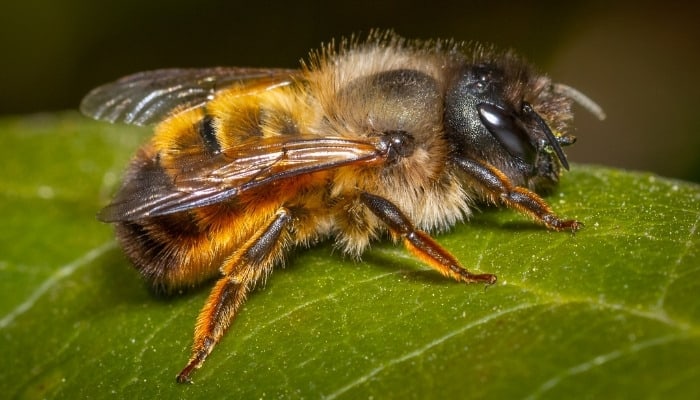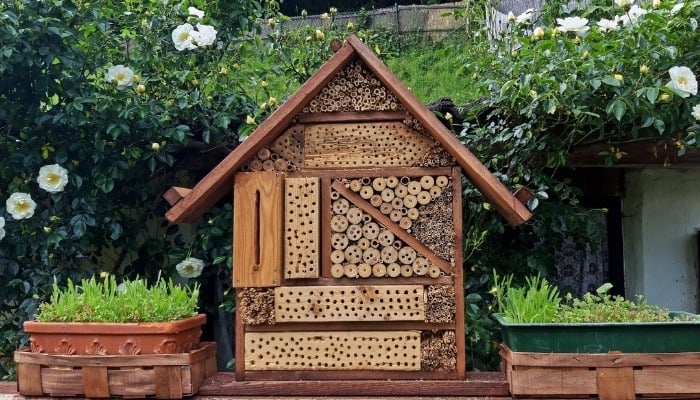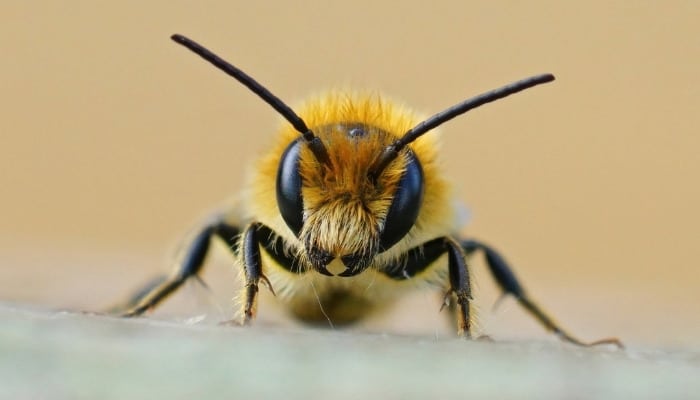If you are seeking a solution for pollinating your garden’s flowers, herbs, and vegetables, Mason bees are likely to be mentioned in discussions.
Mason bees are one of the best pollinators of the natural world, and for a good reason – they get the job done! They’re also quite fascinating little creatures to get to know.
Many avid gardeners, especially lovers of flowers and fruits, like to welcome mason bees into their outside space.
If you’re thinking about doing the same, understanding a bit more about the mason bee will help you do it the right way.
What are mason bees? Mason bees are solitary bees that get their name from their nest-building habits. They create mud nests/cells in gaps and cracks to they lay their eggs. Mason bees are 120 times more effective as pollinators than bumblebees and honey bees and are considered to be nonaggressive.
If the concept of luring mason bees to your garden is an exciting one, you’re in the right place.
This article provides a concise yet informative overview of everything you need to know about mason bees and how to keep them happy in your outdoor space. Read on to learn more.
Mason Bee Facts
Mason bees are solitary bees, and there are around 140 known species native to North America.
While some might squeal at the sight of a mason bee, it is essential to note that these bees are not aggressive.
Yes, the females do have stingers, but you will find that they avoid using them, even when being handled by humans.
Beekeepers don’t use protective gear when working with mason bees. If your interest has been piqued, it’s time for you to learn a few more mason bee facts.
Below are a few basic facts you should know!
Mason Bee Identification
Female mason bees have pollen-trapping hairs in parallel rows – this apparatus is called a scopa and is found beneath the abdomen. Male mason bees do not have a scopa.
The bees are metallic blue, green, or black and measure 7 to 15 millimeters long (the males are smaller than the females).
They have scissor-like jaws to scoop mud and leaves for nest-making. While females have a stinger, they typically don’t sting, even when handled. Males have no stinger.

Mason Bee Benefits
Mason bees are excellent pollinators. It takes around 300 female mason bees to pollinate an acre of cherries or apples.
Researchers believe that enticing wild mason bees can help counter the negative effects caused by the rapidly declining honey bee population.
Mason Bee Life Cycle
The mason bee’s lifespan is only one month. During winter, fully formed adult bees remain in the cocoon. In early spring, the bee breaks through the cocoon – this takes around two weeks.
When eggs are laid in early spring, male eggs are placed at the nest entrance with females at the back. Males emerge first and wait for females to emerge to begin mating.
After mating, the female stores the semen and starts nesting three to four days later. She will nest in an existing hole and lay her eggs.
She plugs the nest with mud and starts storing food. She uses the semen to fertilize only the eggs she wishes to get females from, and the rest of the unfertilized eggs will become male mason bees.
After a few days, the larvae hatch and feed on the pollen and nectar. In 10 days, they will spin a cocoon and pupate within the cell.
Mason Bees as Pollinators
Only female mason bees are pollinators. The male mason bees are only around for mating.
Mason bees nest within close range of flowers whereas honey bees travel great distances to find food sources.
This means that mason bees accomplish more pollination in a shorter amount of time.
Their scopa allows them to carry a good deal of pollen, which is then easily distributed to other flowers, as opposed to honey bees, which carry most of the pollen collected back to the hive.
In addition, mason bees are rather indiscriminate about flower visitation, unlike other types of bees.
All these facts add up to indicate that mason bees are excellent pollinators and a valuable part of nature.
Mason Bee Nesting
Mason bees will create nests with mud, leaves, and mulch in natural cracks and cavities, including insect holes, hollow stems, woodpecker holes, and similar spots.
They will also nest in artificial cavities such as cardboard tubes, paper straws, or holes drilled into wooden blocks.
Mason Bee Eggs
Mason bee eggs are small, oval eggs that are either gray or brown in appearance. Depending on the temperature, they are laid in early spring and take around one to two weeks to hatch.
Mason Bee Cocoons
After the larvae hatch from the eggs, they spend around 10 days feeding on the nectar and pollen in the nest. After that, they spin a cocoon and pupate within the cell.
Do Mason Bees Make Honey?
Mason bees don’t produce any honey – instead, they collect pollen and nectar that is used to feed their young.
In addition, they don’t live in bee colonies, so there’s no need for them to take pollen back to the hive to turn into honey.
Mason Bees vs. Honey Bees
Mason bees collect pollen over their entire body, especially on their scopa. Honey bees collect pollen that is taken back to the hive and turned into honey.
Whereas the benefit of gathering honey from a honey bee hive is incredibly rewarding, there’s no denying that mason bees are superior pollinators and are just as valuable to people.
Where Do Mason Bees Live?
Mason bees require an environment that provides a substrate for nest building. They also need flowers that bloom in early spring and summer so that they can forage.
The best places for mason bees to live include deciduous forests, shrubs, deserts, and coniferous forests.
They will happily make their home in artificial mason bee houses on your property.

Are Mason Bees Aggressive?
No, mason bees are not aggressive at all.
Do Mason Bees Sting?
Female mason bees have stingers but will rarely ever use them, even when being handled.
Are Mason Bees Dangerous?
Mason bees are entirely safe to have around your property and are very unlikely to sting.
Are Mason Bees Harmful?
Mason bees are not harmful to people or the environment.
Do Mason Bees Damage Houses?
If the opportunity exists, mason bees will nest around your house. The tiny holes they make are essentially harmless.
Still, if you let the holes grow, it can lead to an infestation, or the holes may increase in size, leading to water entering the property or other insects getting into the property.
Are Mason Bees Protected?
Mason bees are not protected and are sometimes eliminated because some view them as “pests.”
Are Mason Bees the Same as Carpenter Bees?
No, mason bees are not the same as carpenter bees. Carpenter bees are much bigger than mason bees, and they are also bare with shiny abdomens, whereas mason bees are fuzzy all over.
Carpenter bees are also much more destructive, leaving behind numerous unsightly holes in wood structures.
Are Mason Bees the Same as Mortar Bees?
Mason bees and mortar bees are the same. Both names refer to the same genus of bee species and are used interchangeably.
Do Mason Bees Return to Old Nests?
When the female is ready to nest, she may return to old nests as long as they are slightly bigger than her current body size. She will use this to lay her eggs.
How To Attract Mason Bees
Mason bees can be attracted by providing a bee house and ensuring there is a mud source nearby.
They are also attracted to certain flowers, including salvia, lavender, sunflowers, black-eyed Susans, catmint, pear blossoms, daisies, and the butterfly bush.
How Do You Get Rid of Mason Bees?
The first step is to ensure that the environment isn’t attractive for mason bees to nest.
Remove any items that provide good nesting gaps, cracks, and crevices, and try using smells that deter bees – these include citronella, eucalyptus, cloves, mint, and neem.
Mason Bee House
Providing a mason bee house or a bee hotel is a great way to attract mason bees to your property.
A mason bee house usually consists of a bundle of bamboo or wooden tubes that the bees can use to reproduce and gather pollen and nectar to feed their young.
When the eggs are laid and the adults die, the new generation takes over the bee house.
Best Mason Bee House – Pollibee Mason Bee House
While there are undoubtedly many mason bee houses on the market, the Pollibee Mason Bee House is a crowd-pleaser.
This unit is a beautiful bee hotel fully coated in wax, providing it with long, waterproof service life.
The tube sizes are ideal for mason bees and make it easy for you to remove the cocoons when required.
In addition, it arrives fully assembled, so all you have to do is hang it in a tree or on your wall with the included 1-meter hanging rope. What’s not to love, right?
Conclusion
With the above information in mind, you can determine if a mason bee population is welcome in your garden or not.
The general consensus among most people, however, is that they are most welcome indeed.
The mason bee is a friendly bee that should be welcomed into any garden space where pollination will be appreciated.
If you’re trying to attract mason bees to your outdoor space, invest in a mason bee house and plant alluring flowers to tempt the little buzzers in – you won’t regret it.

